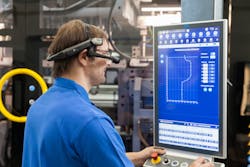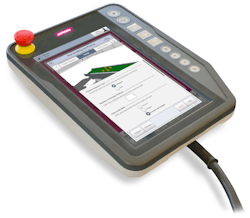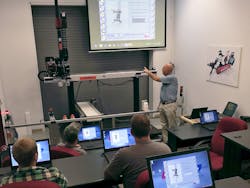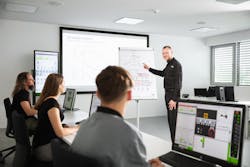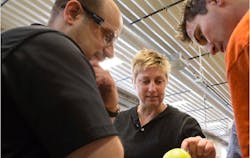By Karen Hanna
Imagine learning to change the oil without ever getting your hands dirty.
“The graphics are extremely lifelike. You actually feel as if you are standing in front of the machine. It’s unbelievable how real it seems,” said Martin Baumann, president and CEO of Arburg Inc., which is working with Kruse Training on VR simulations.
From the hands-on to the high-tech, how training is deployed — and even how much is needed — is changing, thanks in part to an evolution in technology.
Strapped to find workers and fill skill deficits, processors are looking for convenience and ease of use. And OEMs and training providers are working to meet that need.
OEMs lend a hand
According to machinery makers, training starts with machine design. To help their customers, representatives from OEMs said they try to design technologies that don’t require experts to use them successfully.
One strategy for processors involves automation and digitization, said Christian Richard, corporate communications manager and sales administration manager for Bekum Maschinenfabriken GmbH, Berlin.
“This included using digital platforms and tools to deliver training materials, assessments and performance tracking. Automation helped in reducing manual administrative tasks and improving efficiency,” Richard said.
As an example of a technology that is helping users cope, Long pointed to the Quick New program generators on Wittmann’s R9 robot controls, which have eliminated the need for special coding. “The robots write the code after the user answers a few simple questions that the robots ask. Something that used to take two to three hours to do is done within minutes by the robot,” he said.
Arburg is another company that’s working to make operations more intuitive. Its Gestica machine control incorporates features that allow even relative novices to optimize the injection molding process. “Injection parameters are determined automatically based on a CAD file of the part that is uploaded. Simulation software and previous knowledge are not required, so your preparation and programming effort is significantly reduced,” Baumann said.
Virtual assistants available with the Gestica control include aXw Control MeltAssist, which automatically calculates plasticizing capacity, and aXw Control EnergyAssist, which uses the programmed production schedule to automatically heat up and deactivate the cylinder module and mold in a uniform and controlled manner.
“We equip our high-end machines with digital assistance systems to make operating them easier for our customers. But, of course, a certain complexity remains. Training is needed so that people at the machines understand the advantages of our digital assistance systems,” she said.
Learning by doing
Hands-on training, whether at the processing plant or off-site at an OEM’s facility or other setting, remains a popular choice.
“Here, companies tend to rely on the machine suppliers themselves as primary educators,” said Torsten Kruse, president of Kruse Training Inc., which provides interactive online modules to help part designers, mold designers and senior process engineers. “Of course, this choice stems from the fact that the machine suppliers possess the most comprehensive understanding of their own equipment and can provide the best hands-on learning.”
Jeffrey DePuy, technical training specialist for Milacron, said he has noticed that processors increasingly are opting to play host to training, rather than send workers off-site.
“Many of our processing customers have preferred to have the instructor teach the class at their location and on their machine,” he said.
Off-site training can require a commitment, Long said.
While on-site training might take two days, off-site training that requires workers to travel far from their plant might eat up twice as much time.
“That means their people are not doing their normal job duties for days and could cost anywhere from $500 to $5,000 in overall cost,” Long said. “Per student.”
Lesson in convenience
Newer instructional formats, such as web-based courses and 3D modeling programs, can help processing plants avoid disruption to processing schedules, while standardizing training for workers even across multiple sites. They also give workers the freedom to progress at their own pace.
“The pace and amount of information flow has increased, and that’s where I think having a lot of the training online, you can go back and look at it again, and at your own pace is super important for the workforce,” she said.
Web-based training isn’t ideal for certain equipment or levels of users, Wittmann’s Long said, but it has advantages for trainees who might need a second look at the information they’ve been presented. In addition to playing host to training and offering off-site visits, his company puts out webinars and YouTube videos.
“Some things they learn in a training class, the user might not use right away, and they tend to forget some of it. Shorter web-based training allows the equipment suppliers to hold refresher courses when the user really starts to use the equipment features,” he said.
To accommodate busy schedules, the modules can be broken into bite-sized units. Bekum’s Richard promotes the approach, saying, “It was especially effective for busy employees and helped enhance retention.”
Vector Solutions, which provides training, assessments and learning management solutions for manufacturers across a variety of industries, has won awards for its short videos on subjects like safety, Epstein said. While it doesn’t offer in-person training, it’s found a way to create messages that stick.
In some cases, it’s broken down what were once 45-minute lessons into 3- or 5-minute “microlearning” videos, she said.
“It can be more effective in retaining data, and workers can do it on their own phone, on their own time,” she said. “Especially if you’re dealing with younger generations.”
Making it real
One way to blend a hands-on feel with the flexibility of the web is the use of VR and 3D modeling. Some training providers also see potential in artificial intelligence.
“Accessibility and affordability of augmented reality (AR) and virtual reality (VR) integrated systems are steadily improving across various industries,” Kruse said. “Consequently, these technologies are becoming integral in contemporary training systems. The younger generation will come to expect certain advanced training methodologies, so we need to be ready.”
Kruse Training and Arburg are working with CDS Visual, a San Jose company that turns CAD drawings into simulations, to create VR training modules.
3D modeling and animations can help trainees better visualize very small objects, very large machinery, very fast equipment or processes, and areas — such as behind walls or in pipes — that aren’t normally exposed.
The approach also avoids the risk of putting people in unsafe situations or forcing machine downtime, Epstein said.
“For technical fields, like plastics, it really helps people to envision the systems in a way that’s a lot harder to do without the 3D and also much more effective than doing it in real life. Like, you’re not going to take apart necessarily a very expensive piece of machinery to understand how it works, but if you have that 3D modeling, you can actually see how it works,” she said.
Artificial intelligence also might present new opportunities in training.
“We are seeing some AI enter our industry. Companies using AI tools like ChatGPT to allow users to search for troubleshooting topics and have AI provide answers based on their companies’ work orders or processing sheets,” Long said.
He continued: “I think AI manuals and other technology could be seen in use within the next year and then develop more and more as the industry learns more about the technology.”
If the content AI provides isn’t verified, Kruse warned AI-powered training presents risk. However, he said he believes as AI improves, it will exert more influence on training.
But, as Umberto Catignani, who provides training classes and seminars to injection molders, pointed out, nothing can fully replace the experience of running a machine.
“I think the above tools can be helpful but there is absolutely no substitute to implementing process methodologies and information learned from a simulator to a real-world situation,” said Catignani, president of Orbital Plastics Consulting. “A pilot is not hired/promoted/rank determined based on the number of hours he spends in a flight simulator but on the actual number of hours in the air on specific aircrafts.”
Establishing the basics
High technology isn’t the only trend in training.
Sometimes, it’s just identifying an unmet need — or a new audience. While Vector Solutions is working to present training to a more-diverse audience, Routsis Training is exploring ways to address one of the issues underlying plastics’ labor issues — by trying to make opportunities in the industry more appealing to younger people.
According to Vector Solutions, statistics from the U.S. Occupational Safety and Health Administration show that up to one-quarter of job-related accidents could be due to language barriers. To help, in August, the company announced that more than 900 of its courses have been translated into more than 15 languages, including Spanish, Chinese and German. They cover topics that include health, safety and the environment.
“The goal behind that is to really enable this multicultural workforce to receive the same type of important information,” said Epstein, who described Vector Solutions’ mission as being “safer, better and smarter.
Meanwhile, David Routsis, president of Routsis Training LLC, which provides online and in-person training for people who work with blow molding, injection molding and extrusion machinery, is hoping to develop training modules for people who haven’t yet even entered the workforce.
“I hear it from everyone that they’re having a tough time recruiting people, to get them into the companies,” he said “… The big issue that they have is getting new people into the business, so that they could train them and get them as employees of their companies.”
He offered a preview of his vision: “There’s a couple programs that I’m working on now, where we would front-end some of that training, at the high school level, so that we get people interested in it, and then work with somebody in that area, that they would actually pair up with or work with at that particular plant. That way, if we get them in with some of the training, when they go to work for that company and they see what’s there, then that company will end up training them further.”
An IT professional at the university level for 23 years before helming Routsis, he said he wants to help younger people learn about what the plastic industry has to offer them.
“That way, when you go into our high school or somewhere, you could show people, ‘Here’s a career that you could actually have, and here’s what you could make,’ ” Routsis said.
Comprehensive curriculum
Reaching trainees where they’re at in a way that also meets processors’ needs requires flexibility, say representatives of OEMs and training providers who are working to pump out a variety of formats across all levels of the industry.
Whether that means getting your hands dirty or wearing a headset to explore a virtual environment, companies say they’ll continue to innovate.
Engel, for example, continues to look at new ways to provide training.
Neunteufel-Steyer laid out a smorgasbord of offerings: “We see e-learning as a complement to the in-person learning in our training portfolio. Hands-on training at the machine is still essential for operators. New digital technologies might help in specific fields but will not replace practical machine training from our point of view. We are currently working on enriching the digital courses by adding game-like elements. And we are also looking into the question of how far we can use augmented reality in the future.”
The company is also working with universities and research institutes on long-term solutions to the skills gap.
For Bekum, the emphasis is on a tailored approach that recognizes individual employees' needs and skill levels.
“This personalized approach improved engagement and addressed specific gaps in knowledge,” Richard said.
Just keeping a manual on hand is no longer enough.
“The traditional ‘dusty binder’ method no longer resonates with the contemporary workforce,” Kruse said. “Modern recruits require instant access to troubleshooting protocols, onboarding resources and continuous training materials.”
Karen Hanna, senior staff reporter
Contact:
Arburg Inc., Rocky Hill, Conn., 860-667-6500, www.arburg.com
Bekum America Corp., Williamston, Mich., 517-655-4331, www.bekumamerica.com
Engel Machinery Inc., York, Pa., 717-764-6818, www.engelglobal.com
Kruse Training Inc., Naples, Fla., 239-351-7428, www.krusetraining.com
Milacron LLC, Batavia, Ohio, 513-536-2000, www.milacron.com
Orbital Plastics Consulting Inc., Atlanta, 404-849-6714, www.orbitalplastics.com
Routsis Training LLC, Nashua, N.H., 978-957-0700, www.traininteractive.com
Vector Solutions, Tampa, Fla., 813-207-0012, www.vectorsolutions.com
Wittmann USA INC., Torrington, Conn., 860-496-9603, www.wittmann-group.com
About the Author
Karen Hanna
Senior Staff Reporter
Senior Staff Reporter Karen Hanna covers injection molding, molds and tooling, processors, workforce and other topics, and writes features including In Other Words and Problem Solved for Plastics Machinery & Manufacturing, Plastics Recycling and The Journal of Blow Molding. She has more than 15 years of experience in daily and magazine journalism.
